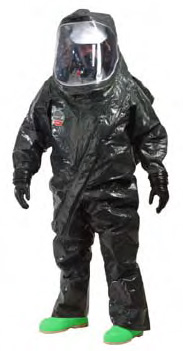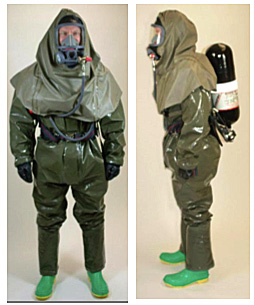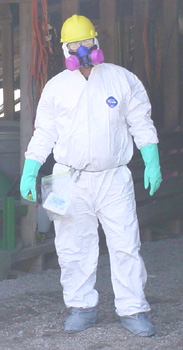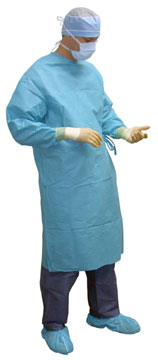PERSONAL PROTECTIVE EQUIPMENT (PPE)
When responding to a WMD incident, responders and healthcare personnel must consider the agent used and the route of dispersal. Knowing these can help determine what personal protective equipment (PPE) is needed, the method of decontamination, and expectation as to the number of possible victims.
Dispersal of biological, chemical, or nuclear contaminants can occur via:
- Aerosolization
- Thermal detonation
- Contamination of food and water
- Human-to-human contact
Regardless of the type of dispersal method used, intended victims are contaminated via three routes: skin, gastrointestinal, and pulmonary.
PPE and Exposure Risks
Just as with Standard Precautions and transmission-based precautions, the components of appropriate PPE are determined by the nature of the anticipated exposure. This includes:
- The nature of the known or suspected hazardous agent (biological, radiological, or chemical), which is the most important factor
- The method(s) of dispersal and exposure (inhalation, skin absorption, ingestion, eye or skin contact)
- The circumstances under which a care provider is exposed
The last is exceptionally important: the closer in time and place the victim is to the exposure incident, the greater the risk to the care provider. This is the rationale for the distinctions between first responder and first receiver (see box below).
FIRST RESPONDERS VS. FIRST RECEIVERS
First responders are personnel who have responsibility to initially respond to emergencies. Some examples are firefighters, HAZMAT team members, law enforcement officers, lifeguards, forestry personnel, ambulance attendants, and other public service personnel. In the case of hazardous materials incidents, these personnel typically respond at the site where the incident occurred.
First receivers are personnel at a hospital or other care site who have a role in receiving and treating contaminated victims, which may include triage, decontamination, medical treatment, and security. In mass casualty incidents, many individuals will arrive at a hospital without having been decontaminated and/or cared for by first responders at the site. For example, in the 2017 Las Vegas shooting, 80% of those patients arriving at one Las Vegas hospital came by private car, cab, or ride-sharing app (Shertz, 2020).
Levels of Protection
There are 4 levels of protection and associated protective equipment, which range from the most protection (A) to the least (D). Protection level is assigned based on the hazardous substance being confronted and must adequately protect the individual from any type of biological, physical, or chemical exposure.
| Level | Protection Provided |
|---|---|
| (U.S. DHHS, 2021a) | |
| A | Highest level of respiratory, skin, and eye protection |
| B | Highest level of respiratory protection, but less skin or outer body protection |
| C | Lower level of respiratory protection; liquid splash protection |
| D | Environmental nuisance contamination only; no respiratory or chemical protection |
LEVEL A PPE
Level A protection is used by first responders when the greatest potential for exposure to hazards exists and when the greatest level of skin, respiratory, and eye protection is required.
Elements:
- Positive pressure, full face-piece, self-contained breathing apparatus (SCBA) or positive pressure supplied air respirator with escape SCBA
- Totally encapsulated chemical- and vapor-protective suit
- Inner and outer chemical-resistant disposable gloves
- Disposable chemical safety boots

Level A–equivalent totally encapsulating chemical- and vapor-protective suit. (Source: U.S. DHHS.)
LEVEL B PPE
Level B protection is necessary for first responders under circumstances requiring the highest level of respiratory protection, with lesser level of skin protection. It is used when ambient atmospheric vapors or gas levels have not approached sufficiently high concentrations to warrant Level A protection.
Elements:
- Positive pressure, full face-piece, self-contained breathing apparatus (SCBA) or positive pressure supplied air respirator with escape SCBA
- Hooded chemical-resistant clothing or suit that provides liquid splash protection
- Coveralls
- Inner and outer chemical-resistant gloves
- Face shield
- Outer chemical-resistant safety boots

Level B–equivalent non-gas-tight encapsulating suit. (Source: U.S. DHHS.)
LEVEL C PPE
Level C protection is required for first responders and first receivers when contact with a chemical will not affect the skin, when the concentration and type of airborne substance is known, and the criteria for using air purifying respirators is met. The chemical protective suit offers liquid splash protection but no protection against chemical vapors or gases. This is the most common level of protection in use today.
Elements:
- Hooded chemical-resistant clothing or suit
- Full-face air purifying respirator
- Inner and outer chemical-resistant gloves
- Hard hat
- Escape mask
- Disposable chemical-resistant outer boots

Level C–equivalent PPE. (Source: U.S. DHHS.)
LEVEL D PPE
Level D is the lowest level required for skin and respiratory protection. It is used when there is no known atmospheric hazard and no risk for splashes or immersion. This level of protection is worn by first receivers, those working in post-decontamination areas, and as Standard Precautions for infection-control purposes.
Elements:
- Gloves
- Coveralls
- Safety glasses
- Face shield
- Chemical-resistant, steel-toed boots or shoes

Level D–equivalent PPE. (Source: U.S. DHHS.)
(EPA, 2020; U.S. DHHS, 2021a)